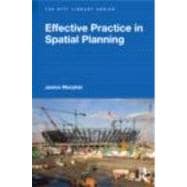
Note: Supplemental materials are not guaranteed with Rental or Used book purchases.
Purchase Benefits
What is included with this book?
| Figures | p. x |
| Preface | p. xi |
| Acknowledgements | p. xiii |
| Abbreviations | p. xiv |
| What is spatial planning? | p. 1 |
| Introduction | p. 1 |
| Spatial planning: theory and practice | p. 2 |
| Spatial planning: an English approach | p. 6 |
| The provenance of spatial planning | p. 13 |
| Conclusions: bringing it all together | p. 20 |
| The local governance context of the English spatial planning system | p. 22 |
| Introduction | p. 22 |
| Local government: the implications of the 2000 reforms for planning | p. 23 |
| Conclusions | p. 45 |
| The English spatial planning system | p. 46 |
| Introduction | p. 46 |
| What are the components of the Local Development Framework? | p. 47 |
| Tests of Soundness (ToS) | p. 70 |
| Conclusions | p. 75 |
| The evidence base of spatial planning | p. 76 |
| Introduction | p. 76 |
| Why is evidence important? | p. 76 |
| Evidence collection and quality | p. 81 |
| Integrated approaches to the use of evidence for spatial planning | p. 83 |
| Consultation processes as evidence | p. 85 |
| Using evidence in spatial planning | p. 85 |
| Specific studies for spatial planning | p. 87 |
| Sustainability Appraisal (SA) | p. 94 |
| Putting evidence in the public domain | p. 97 |
| Conclusions | p. 98 |
| Community involvement in spatial planning | p. 100 |
| Introduction | p. 100 |
| Building social and institutional capital | p. 101 |
| Service users as customers | p. 103 |
| The role of consultation as evidence | p. 104 |
| Consultation requirements in preparing an LDF: Statement of Community Involvement (SCI) | p. 105 |
| Consultation methods | p. 109 |
| Engaging stakeholders | p. 120 |
| The role of Planning Aid | p. 122 |
| Conclusions | p. 122 |
| Making places: delivery through spatial planning | p. 123 |
| Introduction | p. 123 |
| The infrastructure turn | p. 124 |
| Preparing for delivery | p. 128 |
| Working together on an Infrastructure Delivery Plan (IDP) | p. 128 |
| Putting it all together: a Steps Approach | p. 131 |
| Funding delivery | p. 142 |
| Infrastructure delivery strategy | p. 142 |
| Conclusions | p. 145 |
| Infrastructure categories | p. 146 |
| Taking an integrated approach to local spatial delivery | p. 151 |
| Introduction | p. 151 |
| Delivering social objectives | p. 152 |
| Delivering economic objectives | p. 165 |
| Delivering environmental objectives | p. 172 |
| Conclusions | p. 174 |
| Managing spatial planning | p. 175 |
| Introduction | p. 175 |
| Does spatial planning require cultural change for planners? | p. 175 |
| The role of management in effective spatial planning | p. 178 |
| Skills | p. 183 |
| Project management | p. 185 |
| Performance management | p. 189 |
| Development management | p. 194 |
| Conclusions | p. 197 |
| Regional and sub-regional spatial planning | p. 199 |
| Introduction | p. 199 |
| The European context for English regional planning | p. 200 |
| Mega regions in England | p. 202 |
| Regions | p. 205 |
| Sub-regions and city regions | p. 212 |
| The enigma of London | p. 216 |
| Conclusions | p. 217 |
| Spatial planning in Scotland, Wales and Northern Ireland | p. 218 |
| Introduction | p. 218 |
| Scotland | p. 220 |
| Wales | p. 225 |
| Northern Ireland | p. 231 |
| Conclusions: diverging or converging systems of spatial planning? | p. 236 |
| Spatial planning in Europe, North America and Australia | p. 239 |
| Introduction | p. 239 |
| The characteristics of spatial planning in Europe | p. 240 |
| Spatial planning outside Europe | p. 252 |
| Conclusions | p. 257 |
| Spatial planning: what does it all add up to? | p. 258 |
| Introduction | p. 258 |
| The seven Cs of spatial planning | p. 260 |
| What's next for spatial planning? | p. 264 |
| Notes | p. 265 |
| References | p. 266 |
| Index | p. 289 |
| Table of Contents provided by Ingram. All Rights Reserved. |
The New copy of this book will include any supplemental materials advertised. Please check the title of the book to determine if it should include any access cards, study guides, lab manuals, CDs, etc.
The Used, Rental and eBook copies of this book are not guaranteed to include any supplemental materials. Typically, only the book itself is included. This is true even if the title states it includes any access cards, study guides, lab manuals, CDs, etc.